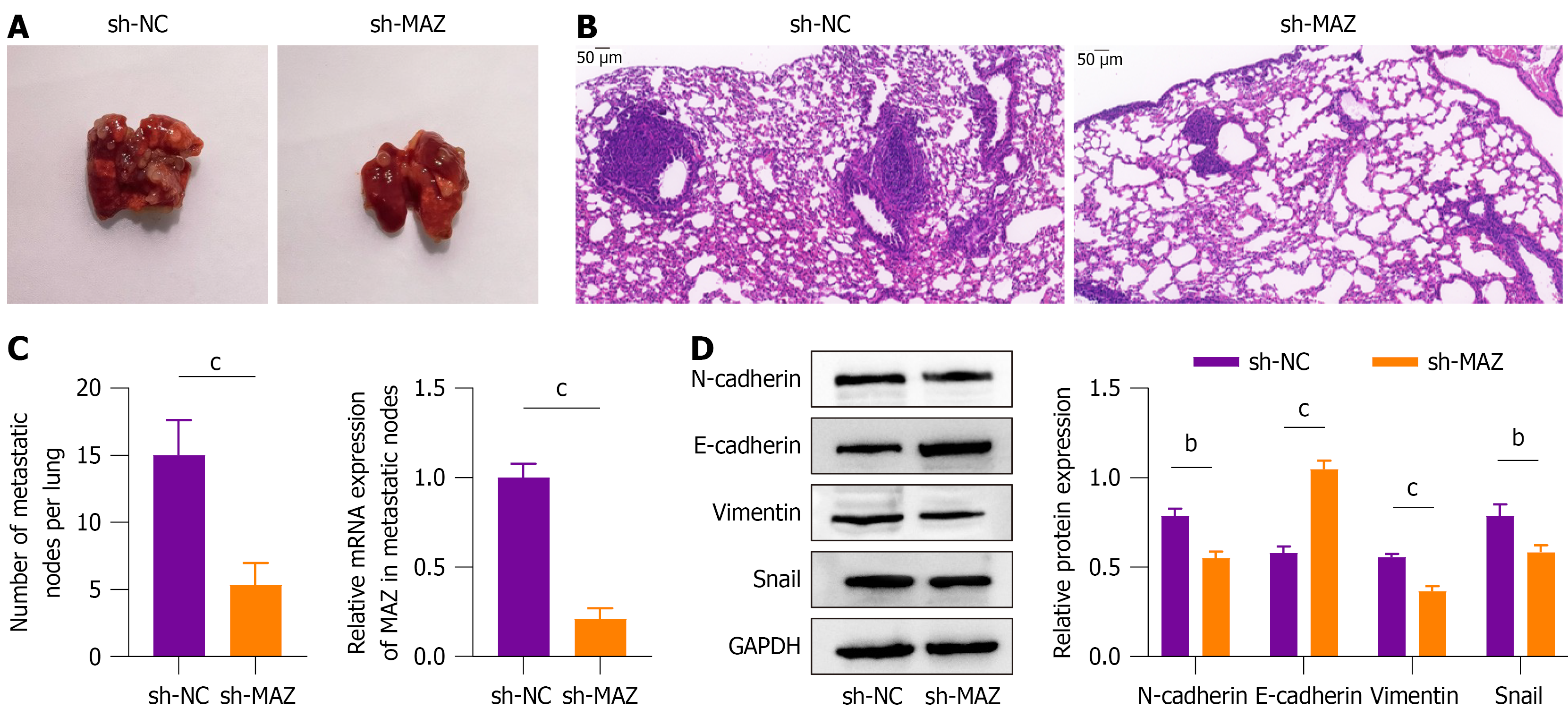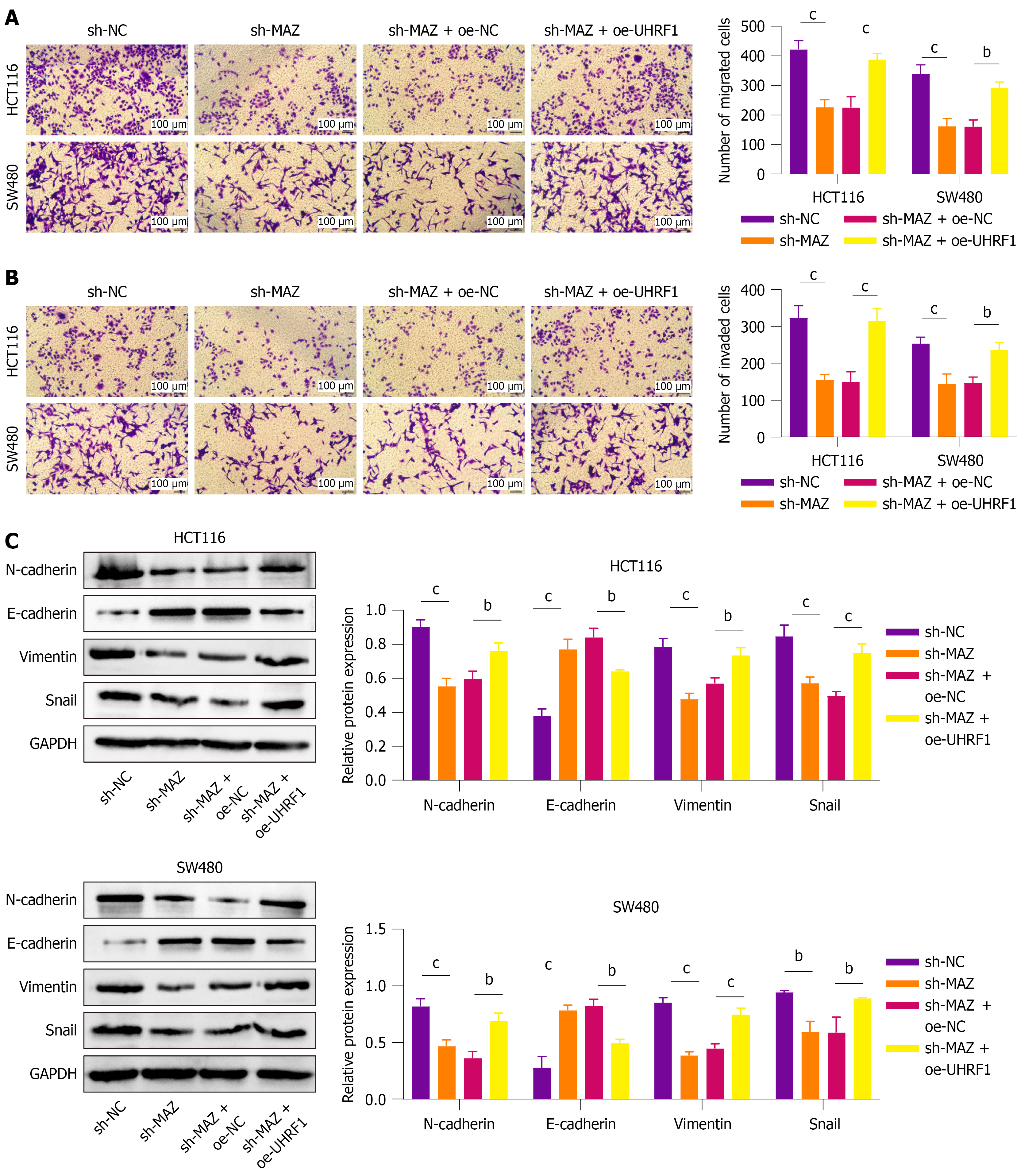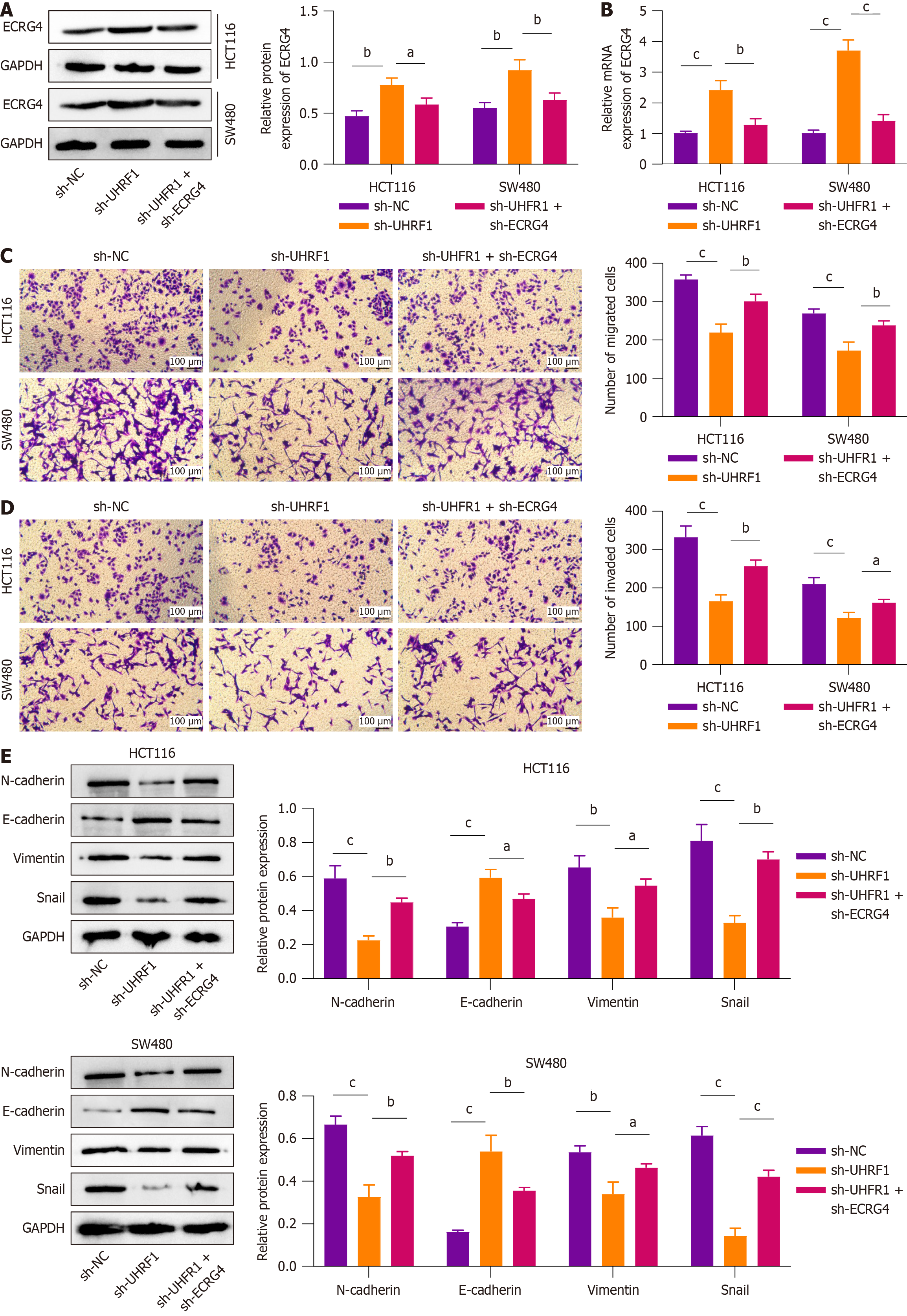Copyright
©The Author(s) 2025.
World J Gastrointest Oncol. Nov 15, 2025; 17(11): 109481
Published online Nov 15, 2025. doi: 10.4251/wjgo.v17.i11.109481
Published online Nov 15, 2025. doi: 10.4251/wjgo.v17.i11.109481
Figure 1 Myc-associated zinc finger protein is highly expressed in colorectal cancer cell lines and promotes cell migration, invasion and epithelial-mesenchymal transition.
A and B: Western blot and quantitative reverse transcription polymerase chain reaction showed the level of Myc-associated zinc finger protein (MAZ) in normal colonic epithelial cells (NCM460) and colorectal cancer (CRC) cell lines (HCT116 and SW480); C and D: Western blot demonstrated knockdown of MAZ expression in CRC cells using short hairpin-RNA (short hairpin-MAZ) targeting MAZ; E and F: Transwell assay images and quantification showed the migration and invasion of CRC cells after MAZ knockdown; G: Western blot showed protein expression of E-cadherin, N-cadherin, vimentin, and snail levels in CRC cells after MAZ knockdown. Data are presented as the mean ± SD. The dashes represent comparisons between groups. The experiments were repeated at least three times independently. MAZ: Myc-associated zinc finger protein; GAPDH: Glyceraldehyde-3-phosphate dehydrogenase; sh: Short hairpin; NC: Negative control. aP < 0.05, bP < 0.01, and cP < 0.0001.
Figure 2 Myc-associated zinc finger protein promotes colorectal cancer metastasis in vivo.
A: Representative images of lung tissues from sh-negative control and sh-Myc-associated zinc finger protein (MAZ) groups showed the metastatic tumor burden (n = 6); B: Hematoxylin and eosin-stained lung tissue sections showed metastatic tumor nodules, with a quantification bar graph comparing the number of nodules in the sh-negative control and sh-MAZ groups, scale bar: 50 μm; C: Quantitative reverse transcription polymerase chain reaction analysis of MAZ mRNA levels in metastatic tumor nodules; D: Western blot of epithelial-mesenchymal transition markers (E-cadherin, N-cadherin, vimentin, and snail) in metastatic tumor nodules. Data are presented as mean ± SD. The dashes represent the comparisons between groups. The experiments were repeated at least three times independently. MAZ: Myc-associated zinc finger protein; GAPDH: Glyceraldehyde-3-phosphate dehydrogenase; sh: Short hairpin; NC: Negative control. bP < 0.01, and cP < 0.0001.
Figure 3 Myc-associated zinc finger protein promotes esophageal cancer-related gene 4 DNA methylation via ubiquitin-like with PHD and RING finger domains 1 activation.
A and B: Western blot and quantitative reverse transcription polymerase chain reaction (PCR) showed ubiquitin-like with PHD and RING finger domains 1 (UHRF1) and esophageal cancer-related gene 4 (ECRG4) level in colorectal cancer cell lines; C: Dual luciferase reporter assay showed binding of Myc-associated zinc finger protein to UHRF1 promoter; D and E: Western blot and quantitative reverse transcription PCR demonstrated UHRF1 knockdown efficiency and its effect on ECRG4 expression; F: Chromatin immunoprecipitation-quantitative PCR showed that UHRF1 was enriched at the ECRG4 promoter in colorectal cancer cells; G: Methylation-specific PCR showed methylation and unmethylation status of the ECRG4 promoter after UHRF1 knockdown. Data are presented as the mean ± SD. The dashes represent the comparisons between groups. The experiments were repeated at least three times independently. MAZ: Myc-associated zinc finger protein; UHRF1: Ubiquitin-like with PHD and RING finger domains 1; ECRG4: Esophageal cancer-related gene 4; GAPDH: Glyceraldehyde-3-phosphate dehydrogenase; sh: Short hairpin; NC: Negative control; oe: Overexpression. aP < 0.05, bP < 0.01, and cP < 0.0001.
Figure 4 Myc-associated zinc finger protein promotes colorectal cancer migration, invasion, and epithelial-mesenchymal transition through ubiquitin-like with PHD and RING finger domains 1 activation.
A and B: Transwell assay images and quantification of colorectal cancer cell migration in different groups: Short hairpin (sh)-negative control, sh-Myc-associated zinc finger protein (MAZ), sh-MAZ + overexpression-negative control, and sh-MAZ + overexpression-ubiquitin-like with PHD and RING finger domains 1; C: Western blot showed that protein expression of epithelial-mesenchymal transition markers (E-cadherin, N-cadherin, vimentin, and snail) in colorectal cancer cells. Data are presented as the mean ± SD. The dashes represent the comparisons between groups. The experiments were repeated at least three times independently. MAZ: Myc-associated zinc finger protein; UHRF1: Ubiquitin-like with PHD and RING finger domains 1; GAPDH: Glyceraldehyde-3-phosphate dehydrogenase; sh: Short hairpin; NC: Negative control; oe: Overexpression. bP < 0.01, and cP < 0.0001.
Figure 5 Ubiquitin-like with PHD and RING finger domains 1 regulates colorectal cancer migration, invasion, and epithelial-mesenchymal transition by DNA methylation-mediated suppression of esophageal cancer-related gene 4.
A and B: Western blot and quantitative reverse transcription polymerase chain reaction showed esophageal cancer-related gene 4 (ECRG4) level in colorectal cancer (CRC) cells after ubiquitin-like with PHD and RING finger domains 1 (UHRF1) knockdown or combined UHRF1 and ECRG4 knockdown; C and D: Transwell assay images and quantification showed the effects of UHRF1 knockdown and simultaneous knockdown of UHRF1 and ECRG4 on CRC cell migration; E: Western blot of E-cadherin, N-cadherin, vimentin, and snail in CRC cells under UHRF1 knockdown or combined UHRF1 and ECRG4 knockdown. Data are presented as the mean ± SD. The dashes represent the comparisons between groups. The experiments were repeated at least three times independently. ECRG4: Esophageal cancer-related gene 4; UHRF1: Ubiquitin-like with PHD and RING finger domains 1; GAPDH: Glyceraldehyde-3-phosphate dehydrogenase; sh: Short hairpin; NC: Negative control. aP < 0.05, bP < 0.01, and cP < 0.0001.
Figure 6 Molecular mechanisms by which Myc-associated zinc finger protein promotes colorectal cancer progression.
In colorectal cancer cells, Myc-associated zinc finger protein transcription activates ubiquitin-like with PHD and RING finger domains 1 and promotes esophageal cancer-related gene 4 DNA methylation leading to colorectal cancer tumor metastasis. CRC: Colorectal cancer; MAZ: Myc-associated zinc finger protein; UHRF1: Ubiquitin-like with PHD and RING finger domains 1; ECRG4: Esophageal cancer-related gene 4; EMT: Epithelial-mesenchymal transition.
- Citation: Mao HQ, Yu FC, Hu DQ, Zhang LJ. Myc-associated zinc finger protein drives colorectal cancer metastasis through activating ubiquitin like with ring finger protein one. World J Gastrointest Oncol 2025; 17(11): 109481
- URL: https://www.wjgnet.com/1948-5204/full/v17/i11/109481.htm
- DOI: https://dx.doi.org/10.4251/wjgo.v17.i11.109481


















